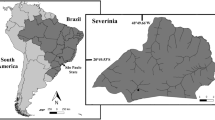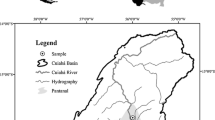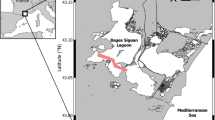Abstract
The biology, population dynamics, and production of Tylos europaeus were studied in two sandy beaches of the western coast of Portugal. At both sites, reproduction occurred seasonally, from April to July, with only one new cohort produced per year. Regarding population dynamics, cohort-splitting events were detected in males at the beginning of the reproduction period (April/May), resulting in two groups with distinct growth rates (fast-growing vs slow-growing males). Different biological characteristics were consequently detected in these two groups, namely regarding body size, lifespan, and contribution to the reproductive effort. Lifespan was estimated as approximately 3 years, for females and fast-growing males, and 4 years for slow-growing males. Cohort-splitting among males appeared as a possible strategy to cope with the highly male-biased sex ratios observed, which could lead to a strong male-male competition for mating. T. europaeus appeared as an annual species, with a univoltine life-cycle (one generation per year), and iteroparous females reproducing twice during their lifespan. Average growth production (P) was estimated at 0.082 g.m−2.yr−1 AFDW (ash-free dry weight) and the average annual biomass (B̄) (standing stock) at 0.052 g.m−2, resulting in a P/B̄ ratio of 1.58. These results produced baseline information for the construction of a population-dynamics model and highlighted the potential of this species as an environmental quality-assessment bioindicator on sandy shores.








Similar content being viewed by others
References
Achouri MS, Charfi-Cheikhrouha F, Marques JC (2003) Biology, population structure, and field-growth rates of Porcellionides pruinosus (Brandt, 1833) (Isopoda, Oniscidea) at Garat Nâam (Kasserine, Tunisia). Crustaceana 75:1241–1262
Benke AC (1979) A modification of the Hynes method for estimating secondary production with particular significance for multivoltine populations. Limnol Oceanogr 24:168–171
Brown AC, McLachlan A (1990) Ecology of sandy shores. Elsevier, Amsterdam
Brown AC, Trueman ER (1996) Burrowing behaviour and cost in the sandy-beach oniscid isopod Tylos granulatus Krauss, 1843. Crustaceana 69:425–437
Caubet Y (1998) Individual life histories in terrestrial isopod populations: a simulation program. Isr J Zool 44:423–437
Colombini I, Aloia A, Fallaci M, Chelazzi L (1996) Spatial and temporal strategies in the surface activity of some sandy beach arthropods living along the French Atlantic coast. Mar Biol 127:247–257
Fallaci M, Colombini I, Taiti S, Chelazzi L (1996) Environmental factors influencing the surface activity and zonation of Tylos europaeus (Crustacea: Oniscidea) on a Tyrrhenian sandy beach. Mar Biol 125:751–763
Gaschütz G, Pauly D, David N (1980) A versatile program for fitting weight and seasonally oscillating length growth data. International Council for the Exploration of the Sea, Council Meeting Papers G24:1–23
Gonçalves SC, Marques JC, Pardal MA, Bouslama MF, El Gtari M, Charfi-Cheikhrouha F (2003) Comparison of Talorchestia brito (Amphipoda, Talitridae) biology, dynamics, and secondary production in Atlantic (Portugal) and Mediterranean (Tunisia) populations. Estuarine Coastal Shelf Sci 58:901–916
Grundy AJ, Sutton SL (1989) Year class splitting in the woodlouse Philoscia muscorum explained through studies of growth and survivorship. Holarct Ecol 12:112–119
Hammer WM, Smyth M, Mulford Jr ED (1969) The behaviour and life history of a sand-beach isopod, Tylos punctatus. Ecology 50:442–453
Hayes WB (1974) Sand-beach energetics: importance of the isopod Tylos punctatus. Ecology 55:838–847
Hayes WB (1977) Factors affecting the distribution of Tylos punctatus (Isopoda, Oniscoidea) on beaches in southern California and northern Mexico. Pac Sci 31:165–186
Kensley B (1972) Behavioural adaptations of the isopod Tylos granulatus Krauss. Zool Afr 7:1–4
Kensley B (1974) Aspects of the biology and ecology of the genus Tylos Latreille. Ann S Afr Mus 65:401–471
Kight SL, Martinez M, Merkulov A (2001) Body size and survivorship in overwintering populations of Porcellio laevis (Isopoda: Oniscidea). Entomol News 112:112–118
Lercari D, Defeo O (2003) Variation of a sandy beach macrobenthic community along a human-induced environmental gradient. Estuarine Coastal Shelf Sci 58S [Suppl A]:17–24
Manning JT (1980) Sex ratio and optimal male time investment strategies in Asellus aquaticus (L.) and A. meridianus Racovitza. Behaviour 74:264–273
Marcadé I, Southy-Grosset C, Bouchon D, Rigaud T, Raimond R (1999) Mitochondrial DNA variability and Wolbachia infection in two sibling woodlice species. Heredity 83:71–78
Marques JC, Gonçalves SC, Pardal MA, Chelazzi L, Colombini I, Fallaci M, Bouslama MF, El Gtari M, Charfi-Cheikhrouha F, Scapini F (2003) Comparison of Talitrus saltator (Amphipoda, Talitridae) biology, dynamics, and secondary production in Atlantic (Portugal) and Mediterranean (Italy and Tunisia) populations. Estuarine Coastal Shelf Sci 58S [Suppl A]:127–148
McLachlan A (1980) The definition of sandy beaches in relation to exposure: a simple rating system. S Afr J Sci 76:137–138
Odendaal FJ, Eekhout S, Brown AC, Branch GM (1999) Aggregations of the sandy-beach isopod, Tylos granulatus: adaptation or incidental-effect? S Afr J Zool 34:180–189
Paoletti MG, Hassall M (1999) Woodlice (Isopoda: Oniscidea): their potential for assessing sustainability and use as bioindicators. Agric Ecosyst Environ 74:157–165
Pardal MA, Marques JC, Metelo I, Lillebø AI, Flindt MR (2000) Impact of eutrophication on the life cycle, population dynamics and production of Ampithoe valida (Amphipoda) along an estuarine spatial gradient (Mondego estuary, Portugal). Mar Ecol Prog Ser 196:207–219
Peterson CH, Hickerson DHM, Johnson GG (2000) Short-term consequences of nourishment and bulldozing on the dominant large invertebrates of a sandy beach. J Coast Res 16:368–378
Richardson AM, Swain R, Wong V (1997) Translittoral Talitridae (Crustacea: Amphipoda) and the need to reserve transitional habitats: examples from Tasmanian saltmarshes and other coastal sites. Mem Mus Victoria 56:521–529
Sunderland KD, Hassall M, Sutton SL (1976) The population dynamics of Philoscia muscorum (Crustacea, Oniscoidea) in a dune grassland ecosystem. J Anim Ecol 45:487–506
Ugolini A, Morabito F, Taiti S (1995) Innate landward orientation in the littoral isopod Tylos europaeus. Ethol Ecol Evol 7:387–391
Williams JA (1995) Burrow-zone distribution of the supralittoral amphipod Talitrus saltator on Derbyhaven beach, Isle of Man—a possible mechanism for regulating desiccation stress? J Crust Biol 15:466–475
Zimmer M, Kautz G (1997) Breeding phonological strategies of the common woodlouse, Porcellio scaber (Isopoda: Oniscidea). Eur J Soil Biol 33:67–73
Acknowledgements
This work was carried out within the scope of the research project “Ecological adaptation and genetic divergence in changing sandy shores. Concepts and guidelines for beach protection and management”, funded by the Portuguese Foundation for Science and Technology (FCT) (POCTI/CTA/36553/00), being also partially supported by the project “Bases for the integrated sustainable management of Mediterranean sensitive coastal ecosystems—MECO” funded by the European Union (IC18-CT98-0270). The research carried out complies with the current laws in the country where it was conducted.
Author information
Authors and Affiliations
Corresponding author
Additional information
Communicated by S.A. Poulet, Roscoff
Rights and permissions
About this article
Cite this article
Gonçalves, S.C., Pardal, M.A., Cardoso, P.G. et al. Biology, population dynamics and secondary production of Tylos europaeus (Isopoda, Tylidae) on the western coast of Portugal. Marine Biology 147, 631–641 (2005). https://doi.org/10.1007/s00227-005-1609-6
Received:
Accepted:
Published:
Issue Date:
DOI: https://doi.org/10.1007/s00227-005-1609-6




